Le fromage
The French consume more cheese per head than any other country in the world!
Each French person eats roughly an amazing 16 kg of cheese per year!
Each region in France produces its own special cheeses.
France is the country that produces the most different types of cheese in the world, around 400 of them at the last count!
There are three types of milk used to produce cheese in France:
- fromage au lait de vache
- fromage au lait de brebis
fromage au lait de chèvre
Fromagerie
A shop that sells cheese, or a place where cheese is made.
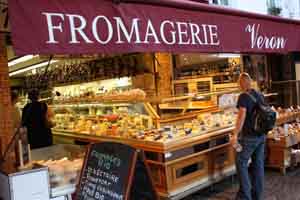
Assiette de fromage
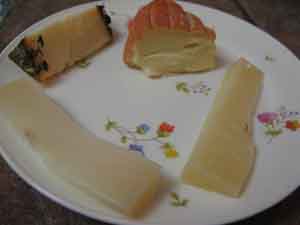
A French cheese plate will offer you at least four or five different types of cheese.
Types of French Cheese
These are the eight types of cheese that are produced in France. Each type has many different varieties
1. Soft Cheeses with Washed Rind
Fromages à pâte molle et à croûte lavée |
These cheeses are all made from cow's milk
The rind is washed during the aging process, which which prevents mould growing on the surface.
The water solution used in washing is enriched with specific bacteria to produce a tasty, colored rind and a specific odour for each cheese. |
Examples:
Munster, Maroilles, Livarot, Pont-l'Evêque, Reblochon and Epoisses
What do you drink with this cheese?
A robust wine, such as a Côtes du Rhône, white wine of the same ragion or a Bordeaux red wine. |
2. Soft Cheses with Natural Rind
Fromages à pâte molle et à croûte fleurie |
These cheeses are made from cow's milk. They are soft cheeses. They are familiar to us, often served in Anglo-Saxon countries as an appetizer. Of course in France, they are always served between the main course and the dessert.
The cheese is not cooked or pressed and it is aged for about a month.
It's a penecillin type mould that produces the soft velvety type of coating around the cheese. |
Examples:
Brie, Camembert, Neufchatel Cheese and Chaource
What do you drink with this cheese?
Young wines, Bordeaux ou Beaujolais.
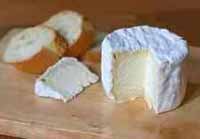
|
3. Cheeses that are cooked and pressed
Les fromages à pâte pressée cuite |
The curd for these cheeses is heated to about 55°C for about an hour before the cheese is pressed and then placed in a mould and set aside to ripen. This is when their well known holes are formed! (though Comté has no holes).
The cheeses are usually formed in large "wheels" or cylinders and are matured in a warm cellar for 3 to 9 months, often longer. They are very calcium rich.
Most of this type of cheese is produced in the mountain areas of France. They are cooking cheeses, used for fondues and as toppings. |
Examples:
Emmental, Gruyère, Comté, Beaufort, Emmental
What do you drink with this cheese?
Fruity white wines, or red wines with "character".
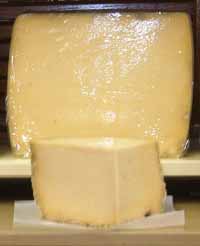
|
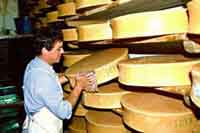 |
The fromagier at work in his "cave" or cellar. The wheels of cheese are large and heavy. |
4. Pressed Cheeses
Fromages à pâte pressée |
These cheeses are not cooked but are pressed, which drains some of the moisture out of the cheese.
After pressing the cheeses are left to mature, from between 15 days to a year, dependent on the variety of cheese. This means the texture of the cheese can be softish to hard - depending on the maturing process. They are kept in tightly controlled conditions.
While they mature, the cheeses are turned regularly, so that their rinds form evenly.
Cheeses made like this can vary in size from just a few kilos to 40 or 50 kilos! |
Examples:
Cantal, St Nectaire, Salers, Reblochon, Ossau-Iraty, Morbier, raclette, Laguiole, tomme
What do you drink with this cheese?
Fruity white wines, like Savoie, a nice red Burgundy, or a young red wine.
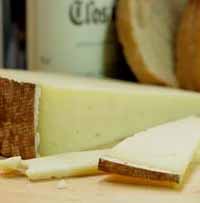
|
5. Fresh Cheeses
Les fromages à pâte fraîche
|
These cheeses can be made from cow's, goat's or ewe's milk.
They are often sold in little pots.
They are different from the other cheeses as:
a. they contain a lot of water
b. they are not left to mature
c. the curd for the cheese is created by lactic
d. you don't get them on a cheese plate, they are eaten separately - often with a spoon.
e. they can be eaten as they are, or can be flavoured, a bit like yogurt
f. sometimes they are used in recipes. |
Examples:
Petit Suisse
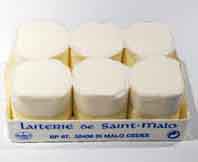
You don't drink wine with this cheese!
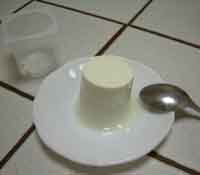
|
6. Processed cheeses
Fromages à pâte fondue |
These are cheeses blended with milk, cream, and butter, which can be either pasteurised or sterilised. You buy them in small portions and they are often flavoured with spices, garlic, herbs, pepper.
They can be kept quite a long time.
They are generally served as a snack - and are loved by children.
"Boursin" (right) is a cheese loved by adults. The slogan "Du pain. du vin et du Boursin" made this cheese very popular for its maker. |
Examples:
"Laughing Cow" is a children's favourite
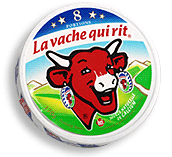
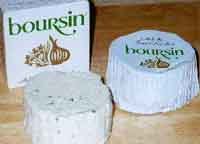
|
7. Blue Cheeses
Fromages à pâte persillées |
These are Blue cheeses, and have veins of blue or green running through them. Most are made from cow's milk. However, Roquefort is made from ewe's milk and is often regarded as the "king of cheese".
The blue veins are created by piercing the cheese with long, fine needles containing "penicillium glaucum" which starts the culture of the blue mould inside the cheese.
These cheeses are left to mature for a long time. They are often highly flavoured and have a strong smell. |
Examples:
Bleu de Bresse, Roquefort, Fourme d'Ambert, Bleu d'Auvergne
What do you drink with this cheese?
Full bodied Bordeaux, such as
St Emilion or a sweet white like Sauternes.
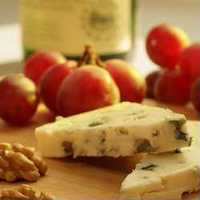
|
6. Goat Cheese
Fromages de chèvre |
This group of cheeses are not distinguished by their preparation method but by thier milk. There are so many types of goat's cheese - from "frais" to dry, creamy, soft, - that they are categorised on their own.
Sometimes the cheese is rolled in wood ashes (cendré) or in herbs and spices. The cheese comes in a huge variety of shapes, little boxes and containers.
"Pur chèvre" is made using only goat's milk. "Mi-chèvre" means the goat's milk has been mixed with cow's milk.
Goat's milk cheese is very healthy since it is very low in chloresterol. |
Examples:
Selles-sur-Cher, Chabichou, Sainte Maure, Picodon, Pélardon, Crottin de Chavignol, Pouligny-Saint-Pierre
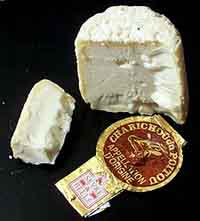
What do you drink with this cheese?
A red Saumur or a Chablis.
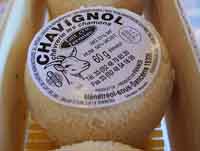
|
|
|
This page is a little beginner's guide to French cheese
Le fromage = cheese
La fromagerie = a cheese shop
Le fromagier = a cheese maker
The most famous saying about cheese is a quote from General de Gaulle, President of France who once moaned: « Comment voulez-vous gouverner un pays où il existe 258 variétés de fromage ? » Was he complaining about the diversity of the people or the cheese? We will never know! what we do know is that there are now even more different types of cheese!
On this page:
Guide to the types of French cheese.
Why so many different types of cheese?
Cheese etiquette.
How to be the perfect guest
when the cheese platter comes round!
Cutting the cheese correctly
Sayings that are about cheese
Some famous cheese dishes you'd find in a restaurant.
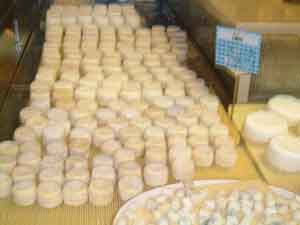
Lots of goat's cheese for sale in the market, and a tasting dish as well!
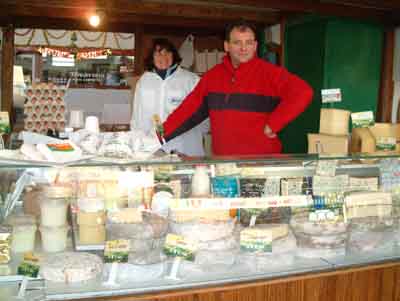
Le fromagier offers many varieties in the market.
Why so many different types of cheese?
Saviez-vous? Did you know?
In the Middle Ages, cheese was one way of preserving milk products for the times of the year when the cows produced less milk.
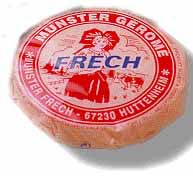 |
There are so many varieties of cheese in France due to the religious orders from the Middle Ages. In every region of France, there were monks, nuns, priests in the abbeys which produced cheese. For example, the cheese from Alsace whichis called "Munster" came from an abbey in Alsace. The German word for "Monastery" is "munster" and the monks gave this bame to both the cheese and the town! |
| Il y a tant de variétés de fromage grâce aux religieux du Moyen Age. Il y avait en chaque région des moines, des sœurs, des prêtres et des abbayes d’où provenaient les fromages. Par exemple, le fromage d’Alsace, le Münster, provenait d’une abbaye en Alsace. Le mot allemand pour « monastère » est « münster » et les moines ont donné ce nom à la ville et au fromage. |
Cheese Etiquette
Cheese is always served after the main course and BEFORE dessert. This is different from Anglo-Saxon countries, where cheese is served AFTER the dessert. Often a green salad will be served between the main course and the cheese.
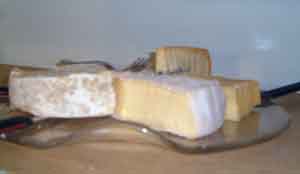
Your host will offer you a plate of four or five cheeses. This will be passed around the table. You don't help yourself from the centre of the table. When the plate comes to you, take a small piece of each cheese. You will have bread to eat with the cheese. You do not spread the cheese onto your bread.
Believe it or not there is a right way and a wrong way to cut your cheese! Here are some tips so you'll do the right thing by yourself, your hosts and the other guests when you're invited to dine out!
Cutting the cheese
Round cheeses. |
| Cheeses that are like logs are cut into slices. |
 |
| Triangular cheeses. |
Brie and Camembert often come in these typical triangle shapes.
Whatever you do with these DON"T cut off the "nose"! This is considered very rude!
If you are the first to cut this cheese, take off a small bit of the "nose", then cut in slices, as shown. It's a bit like slicing a cake! |

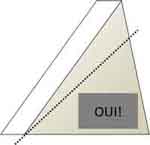
|
| Small wheel shaped cheeses |
Brie and Camembert come like this quite often.
You will need to slice this like a cake. Start with the point of your knife in the centre, then slice outwards. |
 |
| Rectangular hard cheeses |
Cheeses like Gruyère, Emmental and Comté are easy.
Just take a slice cutting through from the rind down to the bottom. |
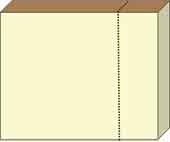 |
Here are some "cheesy" sayings:
| Un repas sans fromage est comme un baiser sans moustache. |
A meal without cheese is like kissing a man without a moustache |
| Tu peux bavarder entre la poire et le fromage |
You can have a good chat at the end of a meal |
| Il n’y a pas de quoi en faire un fromage |
Don't make a big deal/ fuss out of it. |
| Trouver un bon fromage |
To get a cushy job / an easy number |
| Tu ne vas pas en faire tout un fromage ! |
Don't make a big fuss about it! |
| Fromage et pain est médecine au sain |
Bread and cheese are great for doctors your health! |
| Un repas sans fromage est une belle à qui il manque un œil. |
a meal without cheese is like a beautiful woman who has only one eye. |
Fromage, poire et vin,
Repas de vilain. |
Some cheese, wine and a pear
Make a meal for a crook |
How about some cheese dishes?
La raclette
Un plat régional, du fromage grillé, que l'on mange avec des pommes de terre et du saucisson
A regional dish, of toasted cheese which is eaten with potatoes and spicy sausages. |
 |
Le Münster
Un fromage qui pue (ou est très odorant!) mais le goüt est meilleur que l'odeur!)
An extremely smelly cheese (that tastes better than it smells!) |
 |
La fondue
Du fromage Gruyère, cuit avec du vin blanc, dans lequel on trempe un croûton au bout d'une fourchette.
Gruyere cheese cooked with white wine, into which you dunk a little piece of bread on the end of a fork. (Don't drop the bread in the fondue, or you'll have to pay a forfeit, such as offer the host a bottle of wine!) |
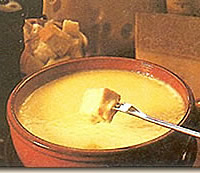 |
Chèvre chaud
Une entrée, avec du chèvre grillé, servi avec un canapé, du mâche, des tomates et des noix.
A starter, warm grilled goat's cheese, served on a canapé with a little green salad, tomatoes and walnuts. |
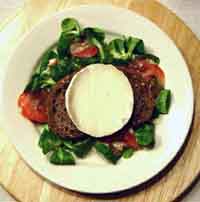 |
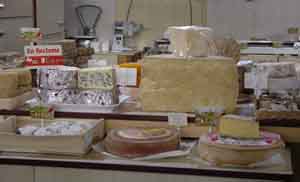
A nice display of cheese in a little village shop
|


























